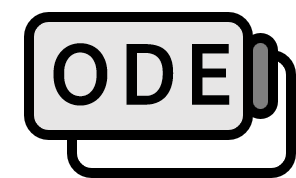Solution to Clairaut's Differential Equation
Definition
The 1st order nonlinear differential equation below is called Clairaut’s equation.
$$ y=xy^\prime+f(y^\prime ) $$
Explanation
The Clairaut differential equation is comparatively easier to solve than other nonlinear differential equations such as the Bernoulli differential equation or the Riccati differential equation.
Solution
Differentiate both sides of the given differential equation $y=xy^\prime+f(y^\prime )$ and then organize.
$$ \begin{align*} && y^\prime = y^\prime+xy^{\prime \prime} + y^{\prime \prime}f^\prime(y^\prime ) \\ \implies && xy^{\prime \prime} + y^{\prime \prime}f^\prime(y^\prime )=0 \\ \implies && y^{\prime \prime} \left[ x + f^\prime ( y^\prime) \right]=0 \end{align*} $$
Case 1. $y^{\prime \prime}=0$
In this case, $y=ax+b$ can be obtained directly. $a,\ b$ is an arbitrary constant. When substituted into the given differential equation, it results in
$$ \begin{align*} && ax+b=xa+f(a) \\ \implies &&b=f(a) \end{align*} $$
Therefore, the general solution is $y=ax+f(a)$. If there are initial conditions, the constant $a$ can be determined accurately.
Case 2. $x+f^\prime (y^\prime )=0$
Organize as $x$ or $y^\prime$ and solve the system of equations with the given differential equation.
■
Below, an example is provided to understand the detailed solution process.
Example
Solve the differential equation $y = xy^\prime + (y^\prime )^2$.
By differentiating both sides,
$$ \begin{align*} &&y^\prime =y^\prime + xy^{\prime \prime} + y^{\prime \prime}2y^\prime \\ \implies && xy^{\prime \prime} + 2y^{\prime \prime}y^\prime =0 \\ \implies && y^{\prime \prime} \left[ x+2y^\prime \right] =0 \end{align*} $$
Case 1. If it’s $y^{\prime \prime}=0$
It’s $y=ax+b$ and $y^\prime =a$. When substituted into the given differential equation, $$ \begin{align*} && ax+b&=ax+a^2 \\ \implies && b&=a^2 \end{align*} $$
Therefore,
$$ y=ax+a^2 $$
Case 2. If it’s $x+2y^\prime =0$
By organizing with respect to $y^\prime$,
$$ y^\prime = 1\frac{1}{2}x $$
When substituted into the given differential equation,
$$ \begin{align*} y&=x\left(- \frac{1}{2}x \right) + \left( \frac{1}{4} x^2 \right) \\ &=-\frac{1}{2}x^2+\frac{1}{4}x^2 \\ &=-\frac{1}{4}x^2 \end{align*} $$
Therefore,
$$ y=-\frac{1}{4}x^2 $$
■
